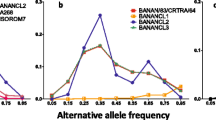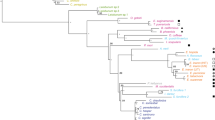Abstract
Application of the amplified fragment length polymorphism (AFLP) technique to genetic mapping studies requires high quality DNA as a template. In the case of Eimeria spp., this has previously been in the form of chromosomal DNA obtained from purified sporozoites recovered from large numbers of oocysts (generally up to 2×108). In order for the AFLP technique to be more easily applied to studies on the genetics of Eimeria maxima, for which only smaller numbers of oocysts are available, a simplified, more efficient method for the recovery of genomic DNA from small numbers of oocysts was developed. Our new method should also be useful for genetic analyses of other coccidial parasites and for the recovery of AFLP-quality DNA from other pathogens.
Similar content being viewed by others
Avoid common mistakes on your manuscript.
Introduction
The amplified fragment length polymorphism (AFLP) technique for the identification of polymorphic DNA fragments has been adopted for the investigation of many prokaryotic and eukaryotic genomes, where it has proven a tool of immense value both to DNA fingerprinting and genetic mapping (e.g. Meksem et al. 1995; Vos et al. 1995; Ajmone-Marsan et al. 1997; Aarts et al. 1998). This technique was recently used to identify most of the polymorphic DNA markers that were used to derive a genetic linkage map of the apicomplexan protozoan parasite, Eimeria tenella (Shirley and Harvey 2000).
AFLP requires 100–250 ng high-quality DNA (e.g. no other contaminating DNA, minimal DNA disruption) as a template for analysis. Shirley and Harvey (2000) used chromosomal DNA obtained from purified sporozoites of E. tenella that were lysed in situ in agarose blocks. Whilst DNA purified in this manner yielded excellent AFLP results, very large numbers of oocysts were required to provide suitably clean sporozoites (the ratio of sporulated oocysts to recovered sporozoites is usually ~1:1). This mitigated against the broader application of the AFLP technique, especially for the less fecund species of Eimeria. A particularly powerful application of AFLP for studies on the molecular basis of major phenotypes of Eimeria spp. would be the analysis of recombinant oocysts produced directly after the imposition of a selection pressure, i.e. without further passage. As part of our work to define the genetic basis of different phenotypes in Eimeria maxima we developed an efficient method for the recovery of genomic DNA suitable as a template for AFLP analyses.
Materials and methods
Parasites
The Houghton (H) strain of E. maxima was used. Oocysts were propagated in Light Sussex chickens reared in a coccidia-free environment and recovered from the faeces as described previously (Long et al. 1976).
Results and discussion
DNA extraction
Genomic DNA was recovered from sporulated oocysts that were smashed in a suspension of glass beads using either a Mini-BeadBeater-8 (Biospec Products, Bartlesville, USA) or a vortex mixer.
BeadBeater extraction
Seven oocyst suspensions, comprising a total of 20, 10, 5, 1, 0.5, 0.2 and 0.1 million oocysts in 20–50 ml sterile deionised water, were pelleted by centrifugation in a bench centrifuge at 500 g for 8 min. Each supernatant was discarded and every pellet was washed three times by centrifugation in TE buffer (10 mM Tris/HCl, 1 mM EDTA in deionised water, pH 8.0) prior to being re-suspended in a 2 ml Eppendorf tube with ~0.5 ml of 1.0 mm glass beads (autoclaved 121°C, 15 min; Jencons-PLS, Leighton Buzzard, UK) in the minimum volume of TE required to cover the solid. Each sample was homogenised in a Mini-BeadBeater-8 for 2–4 20 s bursts at homogenisation speed until almost all oocysts and sporocysts had been broken, as confirmed microscopically. Each sample was then centrifuged (1,500 g) for 1 min to pellet the glass beads and the majority of the oocyst debris. Following supernatant recovery, each pellet was re-suspended in a further 100 µl TE and centrifuged as before. The second supernatant was collected, combined with the first, mixed with 0.33 vol of 10% sodium dodecyl sulphate solution (in deionised water) and incubated at 37°C for 2 h in the presence of proteinase K (100 µg/ml). DNA-free RNase A solution was then added to a final concentration of 20 µg/ml and incubated for a further hour at room temperature. Thereafter, each sample was centrifuged (10,000 g) for 1 min. The DNA suspended in each supernatant was recovered through standard phenol/chloroform extraction and subsequent precipitation with sodium acetate/ethanol (Sambrook and Russell 2001). Each DNA pellet was resuspended in 20 µl double-distilled tissue culture grade water at 4°C overnight.
Vortex mixer
Total genomic DNA was purified from one suspension of 10 million H strain E. maxima oocysts in a process similar to that described above, except that a standard laboratory vortex mixer (Cyclone, Jencons-PLS) was used to break the oocysts. The protocol remained as described above, with the exception that oocysts and beads were resuspended in a volume of 2 ml TE buffer and the oocysts were broken in a sealable, sterile 15 ml glass tube (Corex, USA) by up to five 3 min pulses of vortexing at maximum speed. The tube was placed in ice between bursts.
Chromosomal DNA from sporozoites of the E. maxima H strain was prepared in agarose plugs as described previously (Shirley et al. 1990) and purified for comparative AFLP analysis (Shirley and Harvey 2000) as a control for validation of the oocyst based techniques.
DNA fingerprinting: AFLP
A panel of nine DNA samples was analysed by the AFLP technique using an AFLP kit (Invitrogen Life Technologies, Paisley, UK) in combination with a range of customised primers as described previously for use with E. tenella (Shirley and Harvey 2000). Briefly, the primers used were GTAGACTGCGTACCAATTC (EcoRI) and GACGATGAGTCCTGAGTAA (MseI), with added selective bases of: zero and C (preamplification) and A or T and CA or CC (selective amplification), respectively. All four possible combinations of these primers were analysed. Amplified, 33P-labelled, DNA fragments were separated by electrophoresis through a 6% denaturing polyacrylamide gel (Fig. 1).
AFLP fingerprints generated from DNA samples of the Eimeria maxima H strain, derived from different numbers of oocysts by different techniques. Left to right: L a 50 bp DNA ladder, BB oocysts burst by a BeadBeater (20, 10, 5, 1, 0.5, 0.2 and 0.1×106 oocysts), Vo oocysts burst by vortexing (10×106 oocysts), Sp sporozoite extracted DNA (control, 100×106 sporozoites)
The validity of AFLP fingerprints derived from each sample of genomic DNA was determined by calculating any variation from that of chromosomal DNA using the Jaccard index (SJxy ) and deriving a numerical comparison ranging from 1 (identical) to 0 (Mougel et al. 2002; Table 1).
where n xy =the number of DNA fragments common to both the genomic and chromosomal DNA and Δ xy =the number of polymorphic fragments amplified.
Reproducible AFLP fingerprints were generated from genomic DNA recovered from as few as 0.5 million oocysts (Fig. 1). Use of a smaller number of oocysts yielded AFLP fingerprints that gave a SJxy of less than 1.0 when compared with a sporozoite generated fingerprint (Table 1), suggesting that despite sharing a common template the DNA recovered from less than 0.5 million oocysts is non-representative of the complete genome. In total, 640 bands were amplified by the four selective primer combinations, of which 14.5% and 29.8% were absent from the fingerprints derived from 0.2 and 0.1 million oocysts respectively.
Chromosomal DNA is obtained from highly purified sporozoites recovered from chemically sterilised oocysts. Since no additional DNA fragments were observed after AFLP analyses of genomic DNA derived from oocysts it appears that no bacterial or host DNA contaminated the batches of oocysts, to a level detectable by AFLP, immediately before they were broken (Grech et al. 2002). Similarly, since no bands were absent after AFLP of genomic DNA, the mechanical degradation of DNA must not have been excessive.
Thus, for AFLP of E. maxima, the use of high quality chromosomal DNA offers no technical advantages over that of genomic DNA extracted by the mechanical breaking of oocysts. Utilisation of a BeadBeater resulted in a substantial reduction in preparation time and enabled DNA from several sources to be prepared simultaneously.
A reduction in the numbers of oocysts from 100 million to ≤1 million greatly improves the efficiency of DNA purification for AFLP. Since an infected chicken may produce up to 30 million oocysts during an E. maxima infection, or around 6–8 million per day at peak, it is now possible to use AFLP analyses to examine the outcome of infection within a single bird even on individual days during the course of infection.
The sexual phase in the life cycle of Eimeria spp. makes possible the positional cloning of genes linked with phenotype. Analyses of the inheritance of polymorphic DNA markers in the progeny arising from genetic crosses between two E. maxima strains exhibiting complementary selectable phenotypes can be used to generate genetic linkage mapping groups. A major limitation to the exploitation of such a genetics approach with Eimeria spp. has been the difficulty of producing large numbers of recombinant parasites and the subsequent recovery of DNA from purified sporozoites. The potential to analyse recombinant oocysts of Eimeria immediately after the imposition of intense selection pressures will be a particularly powerful step in genetic analyses.
The techniques described in this paper may prove applicable to studies on other members of the phylum Apicomplexa, for example, Cryptosporidium.
References
Aarts H, van Lith L, Keijer J (1998) High-resolution genotyping of Salmonella strains by AFLP-fingerprinting. Lett Appl Microbiol 26:131–135
Ajmone-Marsan P, Valentini A, Cassandro M, Vecchiotti-Antaldi G, Bertoni G, Kuiper M (1997) AFLP markers for DNA fingerprinting in cattle. Anim Genet 28:418–426
Grech K, Martinelli A, Pathirana S, Walliker D, Hunt P, Carter R (2002) Numerous, robust genetic markers for Plasmodium chabaudi by the method of amplified fragment length polymorphism. Mol Biochem Parasitol 123:95–104
Long P, Joyner L, Millard B, Norton C, (1976) A guide to laboratory techniques used in the study and diagnosis of avian coccidiosis. Folia Vet Lat 6:201–217
Meksem K, Leister D, Peleman J, Zabeau M, Salamini F, Gebhardt C (1995) A high-resolution map of the vicinity of the r1 locus on chromosome v of potato based on RFLP and AFLP markers. Mol Gen Genet 249:74–81
Mougel C, Thioulouse J, Perriere G, Nesme X (2002) A mathematical method for determining genome divergence and species delineation using AFLP. IntJ Syst Evol Microbiol 52 (Pt 2):573–586
Sambrook J, Russell D (2001) Molecular cloning: a laboratory manual.Cold Spring Harbor Laboratory Press, Cold Spring Harbor, N.Y.
Shirley M, Harvey D (2000) A genetic linkage map of the apicomplexan protozoan parasite Eimeria tenella. Genome Res 10:1587–1593
Shirley M, Kemp D, Pallister J, Prowse S (1990) A molecular karyotype of Eimeria tenella as revealed by contour-clamped homogenous electric field gel electrophoresis. Mol Biochem Parasitol 38:169–174
Vos P, Hogers R, Bleeker M, Reijans M, van de Lee T, Hornes M, Frijters,A, Pot J, Peleman J, Kuiper M, Zabeau M (1995) AFLP: a new technique for DNA fingerprinting. Nucleic Acids Res 23:4407–4414
Acknowledgements
The authors wish to acknowledge the technical assistance of Fionnadh Carroll, Pat Hesketh and Andrew Archer. The Biotechnology and Biological Sciences Research Council financially supported this study under grant 201/S15343. The experiments performed in this study comply with UK and EU law.
Author information
Authors and Affiliations
Corresponding author
Rights and permissions
About this article
Cite this article
Blake, D.P., Smith, A.L. & Shirley, M.W. Amplified fragment length polymorphism analyses of Eimeria spp.: an improved process for genetic studies of recombinant parasites. Parasitol Res 90, 473–475 (2003). https://doi.org/10.1007/s00436-003-0890-x
Received:
Accepted:
Published:
Issue Date:
DOI: https://doi.org/10.1007/s00436-003-0890-x





